Your cart is currently empty!
Search results for: “72”
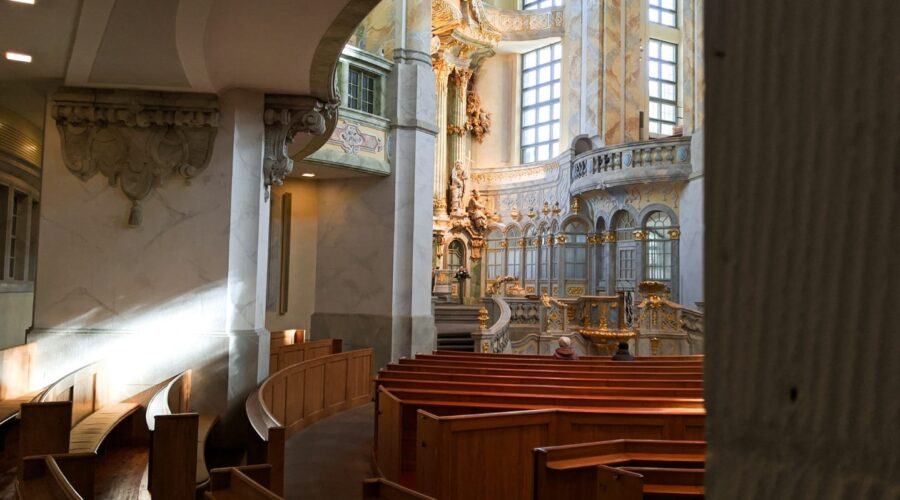
Calvary Church: A Comprehensive Guide for Spiritual Growth and Community
In a world full of distractions and uncertainty, Calvary Church stands as a beacon of hope, offering a vibrant and supportive Christian community where individuals can grow in their faith journey and forge meaningful connections. This guide delves into the history, mission, and key aspects of Calvary Church, providing a comprehensive overview for those seeking spiritual growth and community.
History of Calvary Church
- Founded in 1958 by Pastor Chuck Smith in Santa Ana, California
- Grew rapidly due to its emphasis on contemporary worship and relevant Bible teaching
- Established Calvary Chapel Association in 1965, which supports over 2,000 affiliated churches worldwide
Mission and Vision
Calvary Church’s mission is “to know Jesus Christ and to make Him known” through the following principles:
- Love God with all our heart, soul, mind, and strength
- Love others as ourselves
- Proclaim the Gospel to all nations
- Equip the saints for ministry
The church envisions a global community transformed by the power of the Holy Spirit, where individuals experience a deep connection with God and are empowered to live out their faith in practical ways.
Key Aspects of Calvary Church
Worship Services
Calvary Church offers dynamic and uplifting worship services that include:
- Contemporary Christian music
- Expository preaching from the Bible
- Prayer and intercession
Community and Fellowship
Calvary Church fosters a welcoming and supportive community through various programs and activities, such as:
- Small groups for Bible study and discipleship
- Fellowship events and social gatherings
- Outreach and mission initiatives
Outreach and Missions
Calvary Church is actively involved in reaching out to the community and supporting global missions. Its outreach initiatives include:
- Local food banks, homeless shelters, and community development projects
- Short-term mission trips to various countries
- Financial support to missionaries and humanitarian aid organizations
Leadership and Structure
Calvary Church is led by a team of elders who oversee the church’s spiritual and administrative functions. The church operates with a decentralized structure, empowering local leadership and congregational involvement.
Benefits of Joining Calvary Church
Spiritual Growth
- Access to in-depth Bible teaching and discipleship
- Opportunities for personal study and reflection
- Support and encouragement from a community of believers
Community and Connection
- Build meaningful relationships with like-minded individuals
- Participate in various community events and activities
- Find support and encouragement through small groups and fellowship
Outreach and Service
- Make a difference in the community and beyond
- Contribute to humanitarian aid and mission initiatives
- Live out the Gospel through practical acts of compassion
How to Get Involved with Calvary Church
If you’re interested in learning more or becoming a part of Calvary Church, there are several ways to get involved:
- Attend a worship service
- Visit the church website
- Call the church office
- Contact a member of the leadership team
Calvary Church Locations Location Address Contact Santa Ana, CA (Main Campus) 16300 East 17th Street, Santa Ana, CA 92705 (714) 545-2000 Irvine, CA 1 Spectrum Point Drive, Irvine, CA 92618 (949) 554-9100 Costa Mesa, CA 6555 Bristol Street, Costa Mesa, CA 92626 (949) 556-5100 Los Angeles, CA 1237 South Atlantic Boulevard, Monterey Park, CA 91754 (323) 726-2484 Las Vegas, NV 7600 West Warm Springs Road, Las Vegas, NV 89113 (702) 364-0800 Calvary Church offers a welcoming and inclusive environment where people from all walks of life can find spiritual guidance, community support, and opportunities to grow in their faith. Whether you’re seeking spiritual enrichment, meaningful relationships, or ways to make a positive impact on the world, Calvary Church provides a vibrant and transformative platform for your journey.
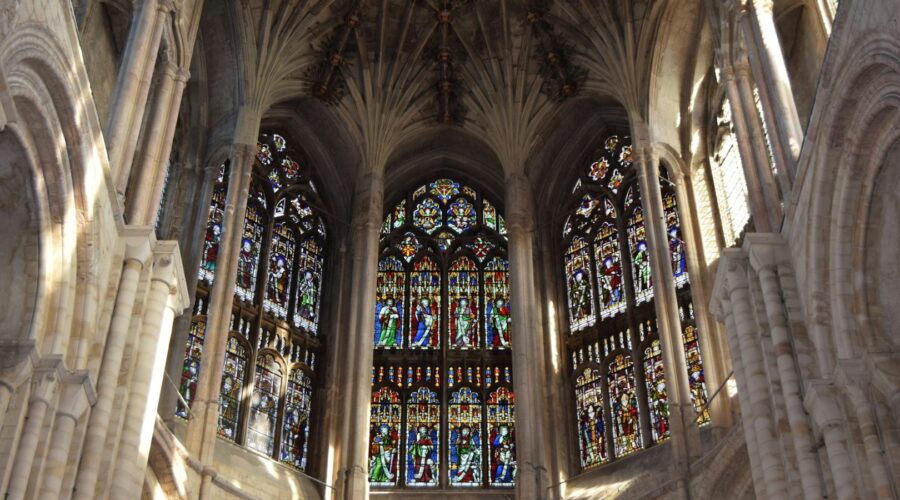
Discover the Enchanting Sagrada Familia: A Timeless Masterpiece of Architecture
Introduction: A Symphony in Stone
The Sagrada Familia, an iconic masterpiece designed by the visionary architect Antoni Gaudí, stands as a testament to the boundless possibilities of human creativity. This monumental basilica in Barcelona, Spain, has captured the imaginations of countless visitors worldwide with its intricate details, soaring spires, and enduring legacy.
History: A Century-Long Journey
The construction of the Sagrada Familia began in 1882, and it remains a work in progress to this day. Gaudí, a devout Catholic, dedicated his life to this ambitious project, envisioning it as an “expiatory temple” built through private donations.
Over the years, the basilica has undergone several architectural changes as different architects took over the project after Gaudí’s untimely death in 1926. However, the original plans and Gaudí’s unique vision have guided the construction, ensuring the preservation of his artistic intent.
Exterior: A Tapestry of Facades
The exterior of the Sagrada Familia is adorned with three monumental facades:
1. Nativity Facade
The Nativity Facade, completed in 1930, is a testament to Gaudí’s passion for nature. It depicts scenes from the birth of Christ, featuring intricate sculptures, vibrant mosaics, and an abundance of symbolism.
2. Passion Facade
The Passion Facade, on the eastern side, was designed by Gaudí’s successor, Josep Maria Subirachs. It showcases the last days of Jesus Christ, with stark and expressive sculptures that reflect the suffering and tragedy of his crucifixion.
3. Glory Facade
The Glory Facade, still under construction, is the most complex and ambitious of the three. It is intended to represent the ascension of Christ and the glory of heaven. Its intricate details and soaring spires promise to make it a breathtaking masterpiece once completed.
Interior: A Forest of Columns
The interior of the Sagrada Familia is equally awe-inspiring. The colossal columns, resembling towering trees, branch out into intricate vaults, creating an ethereal and otherworldly atmosphere. The stained-glass windows, designed by Gaudí, bathe the space in vibrant, multicolored light, adding to the sense of wonder.
Towers: A Symphony of Spires
The Sagrada Familia is crowned by 18 soaring towers, each dedicated to a different biblical figure. The central tower, dedicated to Christ, will reach a height of 172 meters upon completion. The various towers, with their intricate designs and mosaics, create a breathtaking skyline, making the basilica one of the most recognizable landmarks in the world.
Symbolism: A Journey of Faith
Every aspect of the Sagrada Familia is imbued with deep religious symbolism. Gaudí believed that architecture should convey spiritual truths, and he incorporated countless symbols into the design to express his faith.
- The passion facade represents the suffering of Christ, with its stark sculptures and jagged edges.
- The nativity facade celebrates the birth of Christ, with its joyful depictions and intricate floral motifs.
- The interior columns resemble trees, symbolizing the Tree of Life and the connection between heaven and earth.
- The towers represent the apostles, evangelists, and the Virgin Mary, reaching towards the heavens.
Tips for Visiting
- Book your tickets in advance, especially during peak season, to avoid long lines.
- Arrive early to fully appreciate the splendor of the basilica and its exterior.
- Consider taking a guided tour to delve deeper into the history, symbolism, and architectural details.
- Don’t forget to visit the Sagrada Familia Museum to learn more about Gaudí’s life and work.
- Be sure to look up and marvel at the breathtaking interior and the play of light through the stained-glass windows.
Conclusion: A Timeless Treasure
The Sagrada Familia is an architectural masterpiece that transcends time and continues to captivate visitors with its beauty, symbolism, and enduring legacy. As the construction nears completion, it stands as a testament to Gaudí’s genius and the enduring power of human creativity. Whether you are a devout pilgrim or an admirer of architectural wonders, the Sagrada Familia is an unforgettable experience that will inspire and amaze for generations to come.
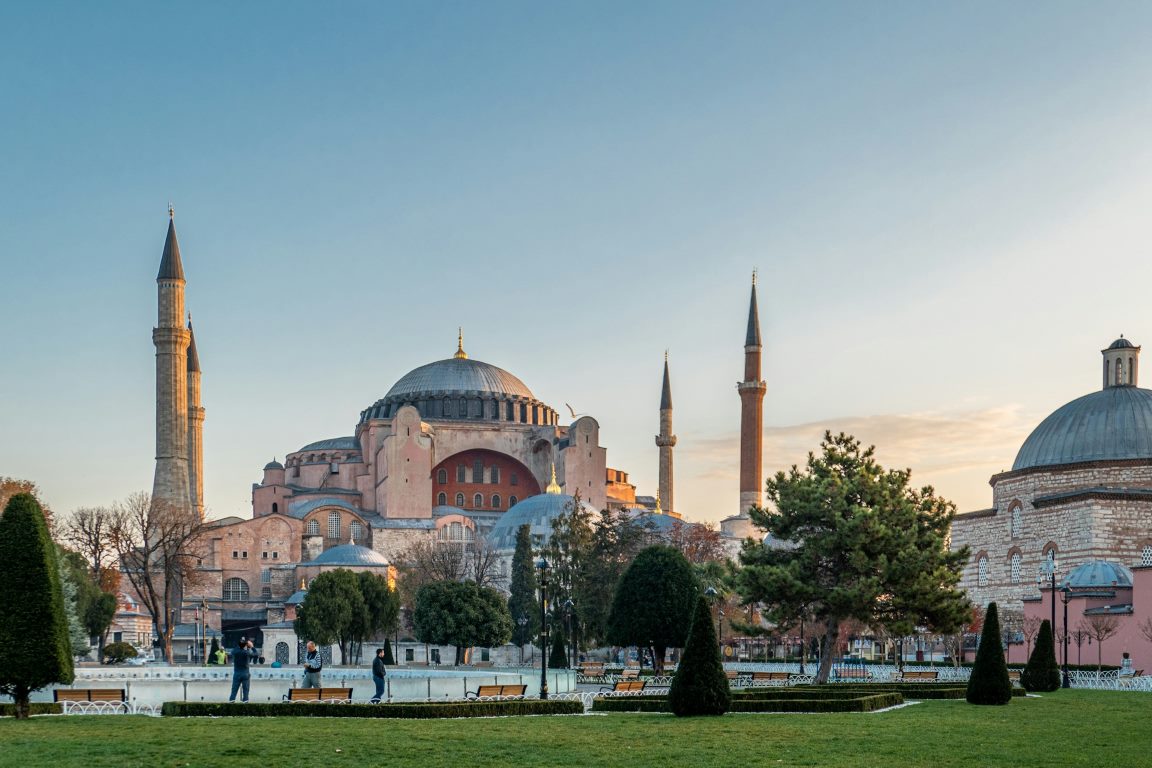
St. Anthony of Padua Church Istanbul
St. Anthony of Padua Church, Istanbul: A Spiritual Gem on Istiklal Avenue
St. Anthony of Padua Church, also known as the Basilica di Sant’Antonio di Padova, is a prominent Roman Catholic church located on the bustling Istiklal Avenue in the Beyoğlu district of Istanbul, Turkey. This magnificent church, with its rich history and stunning architecture, is a testament to the enduring presence of Christianity in a predominantly Muslim country.
Historical Background
The Church of St. Anthony of Padua was originally established in 1725 by the local Italian community in Istanbul. However, the current structure, which stands today, was built between 1906 and 1912. It was designed by the architect Giulio Mongeri in the Venetian Neo-Gothic style, reflecting the grandeur and elegance typical of that period. The church has served as a spiritual and cultural center for the Italian community in Istanbul and continues to be a significant place of worship for Catholics in the city. You can learn more about its history here.
The construction of the church was part of a broader effort to rebuild the Catholic community’s infrastructure after a fire destroyed the original church. The new building was funded by donations from the local Italian community and the Kingdom of Italy. The church was officially opened in 1912 and has since played a vital role in the religious and social life of the community.
Architectural Marvels
St. Anthony of Padua Church is renowned for its stunning architectural features. The exterior is characterized by its red-brick facade and intricate Gothic details, including pointed arches, ornate windows, and spires. The entrance is marked by a large rose window, which is a prominent feature of Gothic architecture. The red brick and white stone exterior, along with the detailed carvings, create a visually striking presence on Istiklal Avenue. Discover more about its architecture on Istanbul Tour Studio and the Turkish Travel Blog.
The interior of the church is equally impressive, with high vaulted ceilings, beautiful stained-glass windows, and elaborate altars. The central nave is flanked by two aisles, each adorned with religious artworks and statues. The church’s serene ambiance makes it a perfect place for reflection and prayer. The stained glass windows, imported from Italy, depict various scenes from the Bible and the lives of the saints, adding to the church’s spiritual atmosphere.
One of the unique aspects of the church’s design is its blend of traditional Gothic elements with local Turkish influences. This combination reflects the multicultural nature of Istanbul and the historical interactions between different cultures and religions in the city. The church’s bell tower, for example, incorporates elements of Ottoman architecture, creating a harmonious blend of Eastern and Western styles.
Cultural and Religious Significance
St. Anthony of Padua Church holds a significant place in the cultural and religious landscape of Istanbul. It is the largest Catholic church in the city and serves as the seat of the Apostolic Vicariate of Istanbul. The church hosts regular masses in various languages, catering to the diverse community of Catholics in Istanbul.
Throughout its history, the church has been a symbol of religious tolerance and coexistence in Istanbul. It has also played an important role in the lives of the local Catholic community, providing a place for worship, community gatherings, and cultural events. The church’s location on Istiklal Avenue, one of the most popular and vibrant streets in Istanbul, makes it a central and accessible place for both locals and tourists. For more on its cultural role, visit Istanbul Tourist Pass and Travel Curious.
Community Engagement and Social Services
Beyond its religious functions, St. Anthony of Padua Church is deeply involved in community engagement and social services. The church runs various programs aimed at supporting the local community, including food distribution, educational support, and healthcare services. These initiatives are an integral part of the church’s mission to serve those in need and promote social justice.
One of the church’s notable programs is its outreach to refugees and migrants in Istanbul. The church provides essential services and support to these vulnerable populations, helping them navigate the challenges of living in a new country. This work is a testament to the church’s commitment to compassion and service, reflecting the core values of the Christian faith.
Special Events and Services
St. Anthony of Padua Church hosts a variety of special events and services throughout the year. These include regular Sunday masses, special masses for holidays and religious festivals, and cultural events such as concerts and art exhibitions. The church is also a popular venue for weddings and other religious ceremonies.
Attending a service or event at St. Anthony of Padua Church provides a unique opportunity to experience the vibrant Catholic community in Istanbul and appreciate the church’s role in the cultural and religious life of the city. The church’s events are well-attended by both locals and tourists, highlighting its significance as a cultural landmark in Istanbul. Details about the church’s events can be found on A Trip to Istanbul and Cornucopia Guide.
Visitor Reviews and Experiences
St. Anthony of Padua Church is highly rated by visitors for its architectural beauty and tranquil ambiance. Many reviewers on platforms like TripAdvisor praise the church for its serene environment, which offers a stark contrast to the busy streets of Istanbul. One visitor described it as “a peaceful oasis in the heart of the city,” while another highlighted the “beautiful stained-glass windows and intricate details” as standout features of the church. These positive reviews reflect the church’s appeal to a wide range of visitors, from religious pilgrims to history and architecture enthusiasts. Read more reviews on TripAdvisor and Viator.
Visiting St. Anthony of Padua Church
Located on Istiklal Avenue, one of Istanbul’s most famous and vibrant streets, St. Anthony of Padua Church is easily accessible and a must-visit for anyone exploring the city. The church is open to visitors daily, and entry is free. It provides a peaceful sanctuary amid the bustling surroundings of Beyoğlu.
Visitors can attend mass, explore the church’s stunning interiors, and learn about its history and significance. The church’s serene atmosphere and beautiful architecture make it a popular spot for both locals and tourists. For more details on visiting the church, including service times and visitor tips, check How to Istanbul and City of Istanbul.
Conclusion
St. Anthony of Padua Church in Istanbul is more than just a place of worship; it is a historical and cultural landmark that embodies the spirit of religious tolerance and coexistence in the city. Its stunning architecture, rich history, and active role in the community make it a must-visit destination for anyone exploring Istanbul. Whether you are drawn by its spiritual significance, architectural beauty, or cultural impact, a visit to St. Anthony of Padua Church offers a profound and enriching experience.
For more information and updates, follow the church’s activities and events on relevant travel and informational websites.
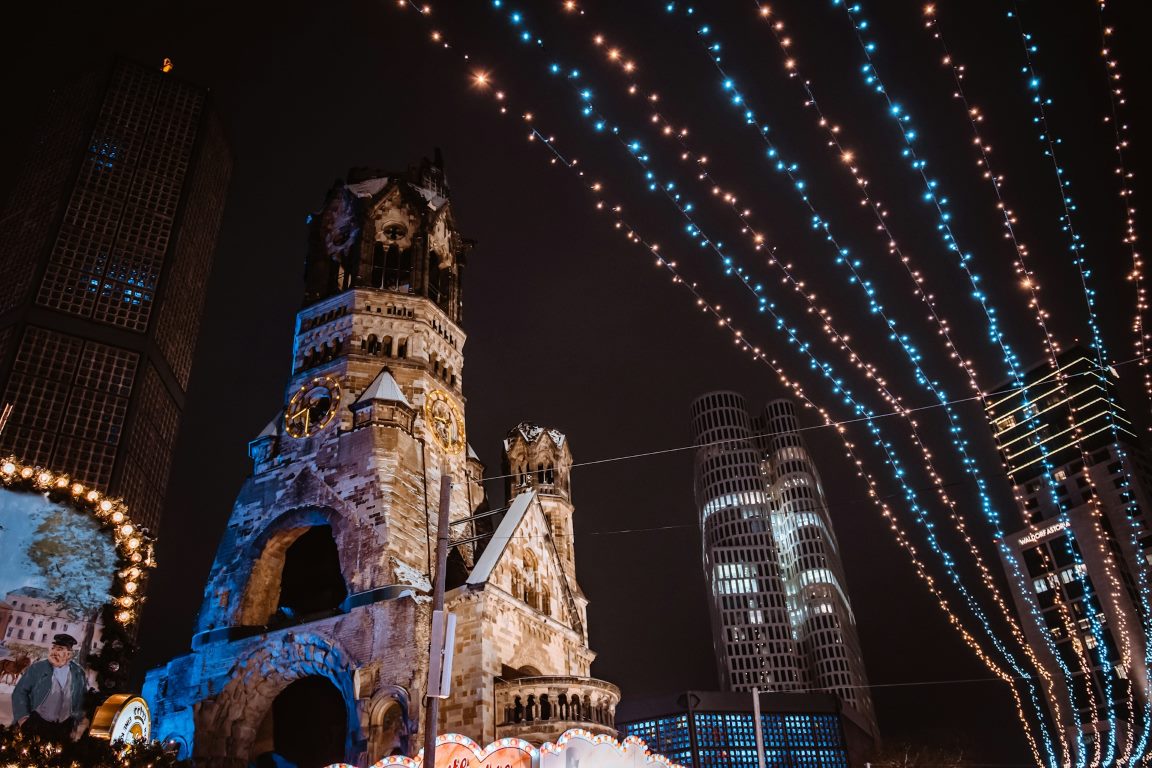
Kaiser Wilhelm Memorial Church Berlin
Kaiser Wilhelm Memorial Church, Berlin: A Testament to History and Resilience
The Kaiser Wilhelm Memorial Church, located in the heart of Berlin, stands as a poignant symbol of the city’s turbulent history and its remarkable resilience. Known locally as the Kaiser-Wilhelm-Gedächtniskirche, this iconic landmark is a must-visit for anyone interested in Berlin’s rich historical and cultural tapestry.
Historical Background
The original Kaiser Wilhelm Memorial Church was built between 1891 and 1895 in honor of Kaiser Wilhelm I, the first Emperor of Germany. Designed by architect Franz Schwechten, the church featured a striking neo-Romanesque design, complete with a towering spire that dominated the Berlin skyline. The church was consecrated in 1895 and quickly became one of Berlin’s most important landmarks. Learn more about its history on Wikipedia.
Tragically, the church was heavily damaged during a bombing raid in 1943, during World War II. Rather than demolish the ruins, the decision was made to preserve the damaged tower as a memorial to the destruction of war and a symbol of peace. This decision has allowed the Kaiser Wilhelm Memorial Church to serve as a powerful reminder of the city’s resilience and its commitment to peace and reconciliation.
Architectural Marvels
The preserved ruins of the original church, often referred to as the “hollow tooth” by Berliners, are juxtaposed with the modern additions designed by architect Egon Eiermann in the 1950s. The new structure includes a hexagonal hall and an octagonal tower, both characterized by their striking use of concrete and blue stained glass. This blend of old and new architecture creates a unique and visually stunning landmark in the heart of Berlin. Discover more about its architecture on Visit Berlin and Lonely Planet.
The interior of the modern church features thousands of blue stained-glass windows, which create a serene and contemplative atmosphere. The nave is illuminated by the soft blue light, making it a peaceful place for reflection and worship. The contrast between the old and new elements of the church highlights Berlin’s ability to blend its rich history with modern design.
Cultural and Historical Significance
The Kaiser Wilhelm Memorial Church is not only an architectural marvel but also a significant cultural and historical site. The church serves as a memorial to the destruction of World War II and a symbol of peace and reconciliation. The preserved ruins of the original church, combined with the modern additions, create a powerful reminder of the impact of war and the importance of striving for peace.
Inside the church, visitors can find exhibits that document the history of the church and its role in Berlin’s history. These exhibits include photographs, artifacts, and personal testimonies that provide a poignant insight into the church’s past and its significance to the local community. The church also hosts regular concerts and cultural events, making it a vibrant part of Berlin’s cultural scene. Learn more about its cultural role on Berlin.de and the Berlin Welcome Card.
Visitor Experience and Reviews
Visitors to the Kaiser Wilhelm Memorial Church often describe it as a moving and reflective experience. The stark contrast between the war-damaged tower and the modern, serene interior offers a powerful visual representation of Berlin’s journey through history. Many visitors are struck by the beauty of the blue stained-glass windows and the peaceful atmosphere within the church.
On TripAdvisor, many reviewers highlight the emotional impact of visiting the church. One reviewer noted, “The church is a sobering reminder of the horrors of war, but also a beautiful testament to resilience and peace.” Another visitor commented on the impressive architecture, stating, “The mix of old and new is stunning. The blue light inside the modern church is simply breathtaking.” Read more reviews on TripAdvisor.
Visiting the Kaiser Wilhelm Memorial Church
Located in the Breitscheidplatz, the Kaiser Wilhelm Memorial Church is easily accessible by public transport and is a popular stop for both tourists and locals. The church is open to visitors daily, and entry is free. Visitors can explore the ruins of the original church, visit the modern chapel, and view the exhibits that document the church’s history.
The church also offers guided tours, which provide a deeper insight into the history and significance of the site. These tours are available in multiple languages and are highly recommended for anyone looking to gain a comprehensive understanding of the church. For more information on visiting, check Introducing Berlin and Urbs Travel.
Special Events and Services
The Kaiser Wilhelm Memorial Church hosts a variety of events throughout the year, including concerts, lectures, and special services. These events are an integral part of the church’s mission to promote peace and reconciliation. The church’s annual Christmas market is particularly popular, attracting visitors from all over the world.
Attending an event at the Kaiser Wilhelm Memorial Church offers a unique opportunity to experience the site’s cultural and historical significance. Whether it’s a concert in the modern chapel or a special service in the historic ruins, these events provide a deeper connection to the church and its message of peace.
Conclusion
The Kaiser Wilhelm Memorial Church in Berlin is more than just a place of worship; it is a powerful symbol of the city’s history, resilience, and commitment to peace. Its unique combination of old and new architecture, its cultural and historical significance, and its role in promoting peace and reconciliation make it a must-visit destination for anyone exploring Berlin.
For more information and updates, follow the church’s activities and events on relevant travel and informational websites.
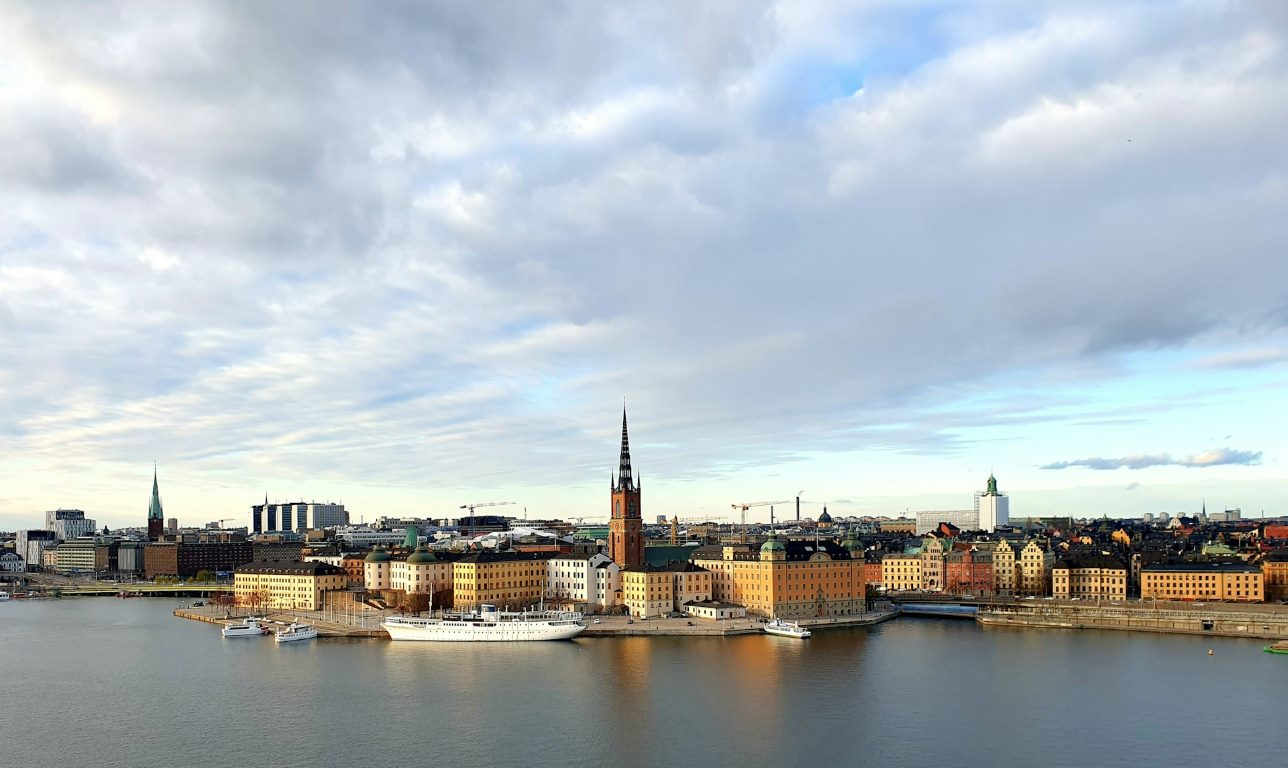
Storkyrkan Stockholm
Storkyrkan, Stockholm: A Testament to History and Heritage
Storkyrkan, also known as Stockholm Cathedral, is one of the most significant and historically rich churches in Stockholm, Sweden. Located in the heart of Gamla Stan, the city’s old town, this stunning cathedral has been a central part of Stockholm’s religious and cultural life for centuries.
Historical Background
Storkyrkan was originally built in the 13th century, making it one of the oldest buildings in Stockholm. Its history is deeply intertwined with the history of the city itself. The church has undergone numerous renovations and expansions over the centuries, evolving from a simple wooden structure to the magnificent Gothic and Baroque edifice it is today. It has been the site of many significant events in Swedish history, including royal coronations and weddings. For a detailed history, visit the Wikipedia page and the Swedish Church site.
Architectural Marvels
Storkyrkan is renowned for its stunning architecture, which combines elements of Gothic and Baroque styles. The church’s exterior is characterized by its towering spire and the intricate brickwork that gives it a distinctive appearance. The interior is equally impressive, featuring high vaulted ceilings, beautiful stained-glass windows, and an array of religious artworks.
One of the most notable features of Storkyrkan is the statue of St. George and the Dragon, created by the German sculptor Bernt Notke in the 15th century. This remarkable piece of art symbolizes the battle between good and evil and is a highlight for many visitors. Additionally, the silver altar and the wooden pulpit are examples of the church’s exquisite craftsmanship. More about the architecture can be found on Svenska Kyrkan and A View on Cities.
Cultural and Historical Significance
Storkyrkan is not just an architectural marvel; it is also a site of immense cultural and historical importance. It has been the main church of the Church of Sweden’s Stockholm diocese since the Reformation in the 16th century. Over the years, it has hosted numerous significant events, including the wedding of Crown Princess Victoria in 2010.
The church is also home to various concerts and cultural events, enhancing its role as a hub of cultural activity in Stockholm. Its historical significance and role in the community make it a must-visit for anyone interested in Sweden’s rich cultural heritage. More about its cultural significance can be found on Musik Storkyrkan St. Jacob and Visit Stockholm.
Visitor Experience and Reviews
Visitors to Storkyrkan often praise its majestic architecture and serene atmosphere. The church is a popular destination for both tourists and locals, who come to admire its beauty and reflect on its historical significance. The detailed artwork and the peaceful ambiance make it a perfect spot for contemplation and exploration.
On TripAdvisor, many visitors highlight the church’s impressive interior and its historical artifacts. One reviewer noted, “Storkyrkan is a must-see in Stockholm. The architecture is breathtaking, and the history behind it is fascinating.” Another visitor commented, “The statue of St. George and the Dragon alone is worth the visit.” Read more reviews on TripAdvisor.
Visiting Storkyrkan
Storkyrkan is conveniently located in Gamla Stan, making it easily accessible by public transport. The church is open to visitors daily, and guided tours are available to provide deeper insights into its history and architecture. The surrounding area is filled with charming streets, shops, and cafes, offering a perfect day out in Stockholm’s historic district.
Visiting Storkyrkan offers a unique opportunity to explore one of Stockholm’s most significant landmarks. Whether you are interested in its architectural beauty, historical significance, or cultural activities, the church provides a rich and rewarding experience. For more information on visiting, check Stockholm Museums and Travel Curious.
Special Events and Services
Storkyrkan hosts a variety of events throughout the year, including religious services, concerts, and cultural events. These events are an integral part of the church’s mission to promote community engagement and cultural heritage. The church’s festive events, especially during major religious holidays, attract numerous visitors and locals alike, creating a lively and spiritually enriching atmosphere.
Attending an event at Storkyrkan offers a unique opportunity to experience the church’s cultural and historical significance. Whether it’s a traditional religious ceremony or a classical music concert, these events provide a deeper connection to the church and its community. More information about upcoming events can be found on Musik Storkyrkan St. Jacob.
Conclusion
Storkyrkan in Stockholm is more than just a place of worship; it is a cultural and historical treasure that embodies the spirit of Stockholm. Its stunning architecture, rich history, and active role in the community make it a must-visit destination for anyone exploring Stockholm. Whether you are drawn by its architectural beauty, historical significance, or cultural impact, a visit to Storkyrkan offers a profound and enriching experience.
For more information and updates, follow the church’s activities and events on relevant travel and informational websites.
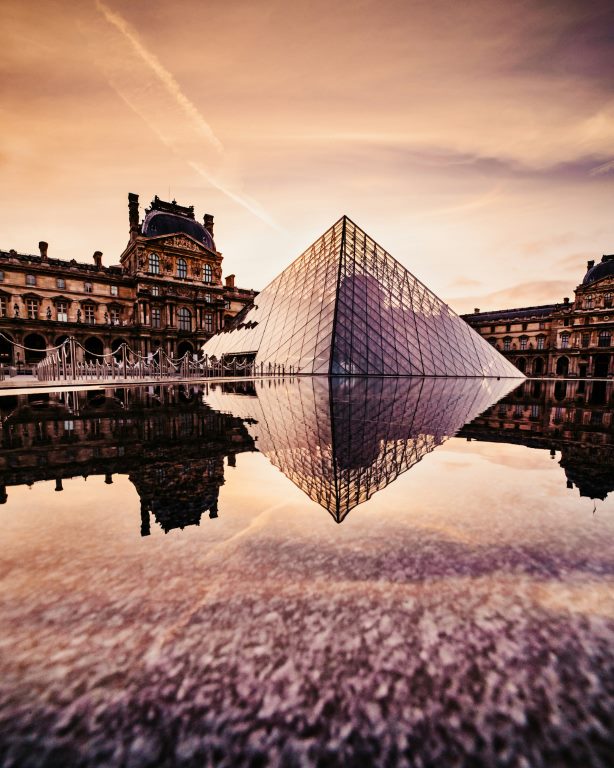
Church of Saint-Étienne-du-Mont in Paris
Church of Saint-Étienne-du-Mont, Paris: A Historical and Architectural Gem
The Church of Saint-Étienne-du-Mont, located in the heart of Paris, is a stunning example of Gothic and Renaissance architecture. This historical church is not only a place of worship but also a significant cultural and historical landmark in the city.
Historical Background
The Church of Saint-Étienne-du-Mont was originally established in the 6th century as part of the Abbey of Sainte-Geneviève. The current structure was built between 1492 and 1626, showcasing a blend of Gothic and Renaissance styles. The church is dedicated to Saint Stephen and houses the shrine of Sainte Geneviève, the patron saint of Paris. For a detailed history, visit the Wikipedia page and the church’s official historical account.
Architectural Marvels
Saint-Étienne-du-Mont is renowned for its unique architectural features. The church’s facade combines elements of Gothic and Renaissance architecture, characterized by its intricate stone carvings and ornate rose window. The interior is equally impressive, featuring a stunning rood screen, one of the few remaining in Paris, and beautiful stained-glass windows that date back to the 16th century.
The church also boasts an elaborate pulpit and a grand organ, which are significant highlights for visitors. The rood screen, a finely carved stone structure, separates the nave from the chancel and is considered a masterpiece of Renaissance art. More about the architecture can be found on Travel France Online and Lonely Planet.
Cultural and Historical Significance
The Church of Saint-Étienne-du-Mont holds immense cultural and historical significance. It is the final resting place of Sainte Geneviève, whose shrine attracts pilgrims from around the world. The church also played a role in Victor Hugo’s “Les Misérables,” where it is described as a place of refuge for the protagonist, Jean Valjean.
In addition to its religious importance, the church has been a site for numerous cultural events and concerts, enhancing its role as a hub of cultural activity in Paris. Its historical significance and role in the community make it a must-visit for anyone interested in Paris’s rich cultural heritage. More about its cultural significance can be found on Un Jour de Plus à Paris and Urbs Travel.
Visitor Experience and Reviews
Visitors to the Church of Saint-Étienne-du-Mont often praise its breathtaking architecture and serene atmosphere. The church is a popular destination for both tourists and locals, who come to admire its beauty and reflect on its historical significance. The intricate details of the rood screen and the stunning stained glass are particularly noted for their artistic value.
On TripAdvisor, reviews frequently highlight the church’s impressive interior and its historical artifacts. One reviewer noted, “Eglise Saint-Étienne-du-Mont is a hidden gem in Paris. The architecture is stunning, and the history behind it is incredibly moving.” Another visitor commented, “This church is a must-visit for anyone interested in Paris’s rich history. The stained glass and the peaceful atmosphere are unforgettable.” Read more reviews on TripAdvisor.
Visiting the Church of Saint-Étienne-du-Mont
Located near the Panthéon in the Latin Quarter, the Church of Saint-Étienne-du-Mont is easily accessible by public transport. The church is open to visitors daily, and guided tours are available to provide deeper insights into its history and architecture. The surrounding area is also home to several other notable landmarks, making it an ideal destination for a day of exploration in Paris.
Visiting the Church of Saint-Étienne-du-Mont offers a unique opportunity to explore one of Paris’s most significant religious and cultural sites. Whether you are interested in its architectural beauty, historical significance, or spiritual atmosphere, the church provides a rich and rewarding experience. For more information on visiting, check Paris Walking Tours and EUTouring.
Special Events and Services
The Church of Saint-Étienne-du-Mont hosts a variety of events throughout the year, including religious ceremonies, concerts, and cultural events. These events are an integral part of the church’s mission to promote community engagement and cultural heritage. The church’s festive events, especially during major religious holidays, attract numerous visitors and locals alike, creating a lively and spiritually enriching atmosphere.
Attending an event at the Church of Saint-Étienne-du-Mont offers a unique opportunity to experience the church’s cultural and historical significance. Whether it’s a traditional religious ceremony or a classical music concert, these events provide a deeper connection to the church and its community. More information about upcoming events can be found on Theatre in Paris and Musictick.
Conclusion
The Church of Saint-Étienne-du-Mont in Paris is more than just a place of worship; it is a cultural and historical treasure that embodies the spirit of Paris. Its stunning architecture, rich history, and active role in the community make it a must-visit destination for anyone exploring Paris. Whether you are drawn by its architectural beauty, historical significance, or cultural impact, a visit to the Church of Saint-Étienne-du-Mont offers a profound and enriching experience.
For more information and updates, follow the church’s activities and events on relevant travel and informational websites.
Sint Jan In Gouda, Holland
Sint Jan in Gouda, the Netherlands’ longest church, known for its 72 famous stained glass windows, open to the public year-round.
Cathedral Of Saint James Or Innsbruck Cathedral In Innsbruck, Austria
The Cathedral of St. James in Innsbruck, Austria, a Baroque cathedral with pink marble and gold leaf decorations, houses the tomb of Archduke Maximilian III and an impressive organ with 3,729 pipes.
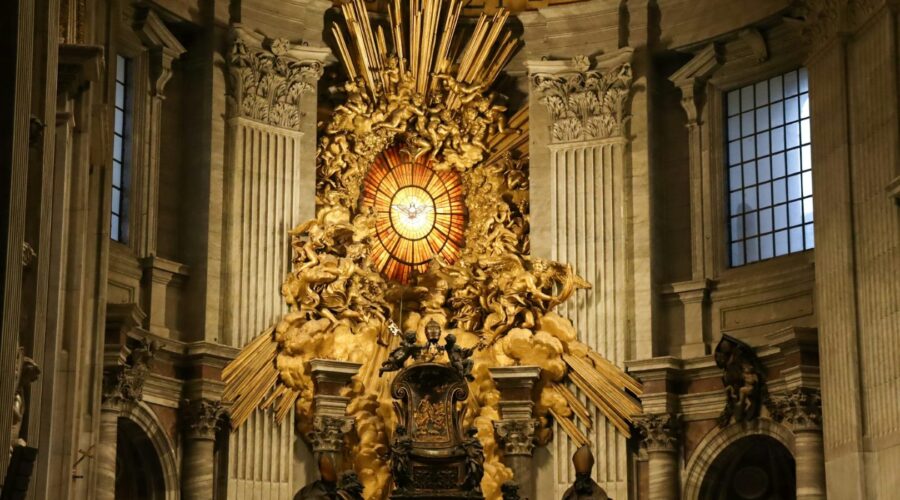
The Evolution of Church Architecture: From Ancient to Modern Times
Church architecture has evolved significantly over the centuries, reflecting changes in religious practices, cultural influences, and technological advancements. From the grandeur of ancient basilicas to the simplicity of modern churches, each architectural style tells a story of the time in which it was built. In this blog post, we will explore the fascinating evolution of church architecture, highlighting key styles and their defining characteristics.
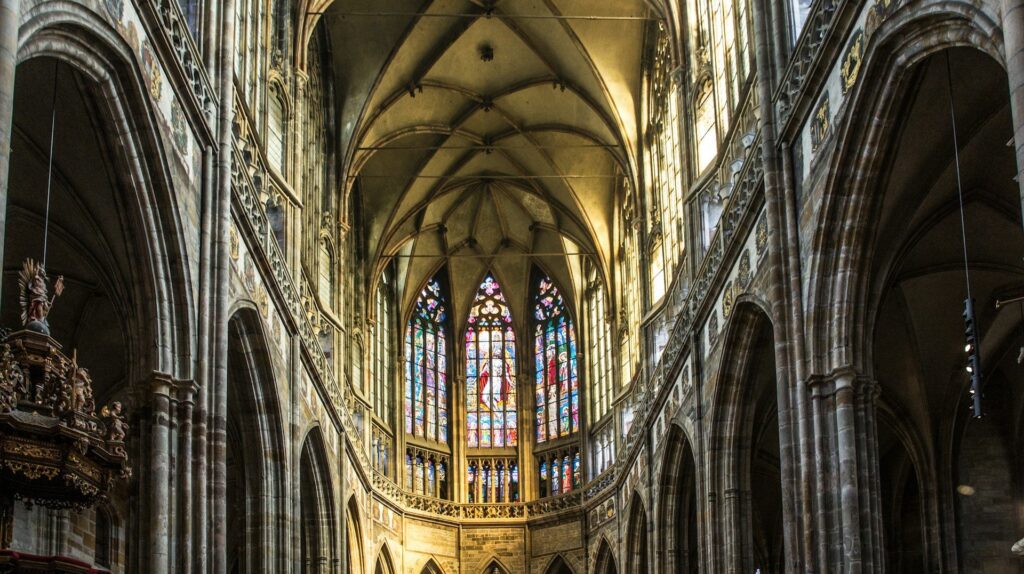
1. Early Christian Architecture
Historical Background
Early Christian architecture, dating from the 4th to the 6th centuries, marked the beginning of church building as we know it today. With the legalization of Christianity under Emperor Constantine, Christians were able to construct large public places of worship.
Key Features
- Basilica Plan: Early churches were often modeled after Roman basilicas, featuring a rectangular layout, a central nave flanked by aisles, and an apse at one end.
- Simple Exteriors: The exteriors were typically plain, with little decoration, reflecting the early Christian emphasis on inner spiritual life.
- Mosaics and Frescoes: Interiors were adorned with religious mosaics and frescoes, depicting biblical scenes and saints.
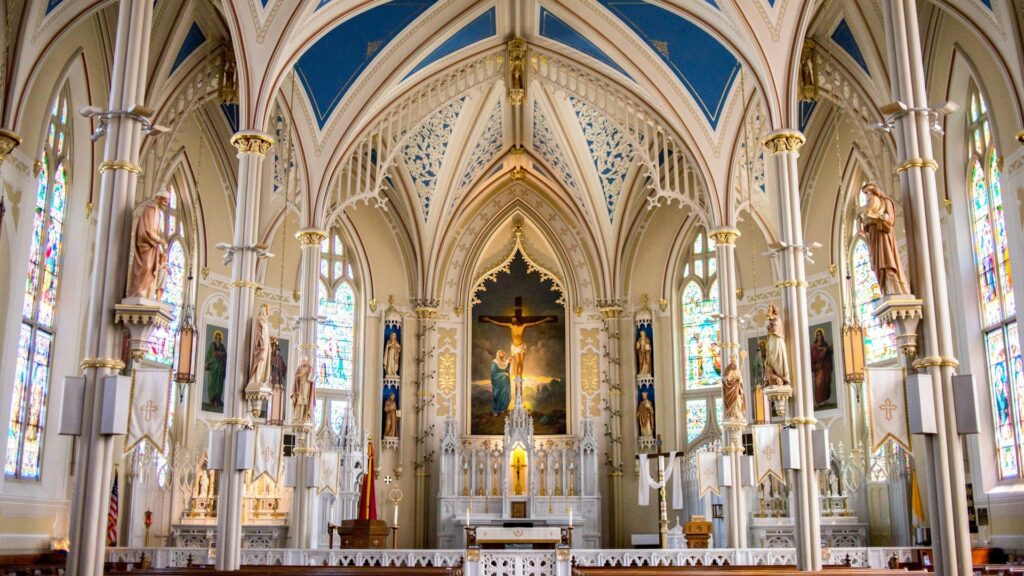
2. Romanesque Architecture
Historical Background
Romanesque architecture emerged in the 10th century and lasted until the 12th century. This style is characterized by its massive quality, thick walls, and sturdy construction, which were practical for the tumultuous times of the early medieval period.
Key Features
- Rounded Arches: Romanesque churches are known for their rounded arches, both in windows and doorways.
- Barrel Vaults: The use of barrel vaults and groin vaults allowed for stronger and more fire-resistant roofs.
- Thick Walls and Small Windows: These features provided the necessary support for heavy stone roofs and created a sense of solidity and fortification.
- Decorative Elements: Sculpture and relief carvings depicting biblical stories and symbolic motifs were common around doorways and capitals.
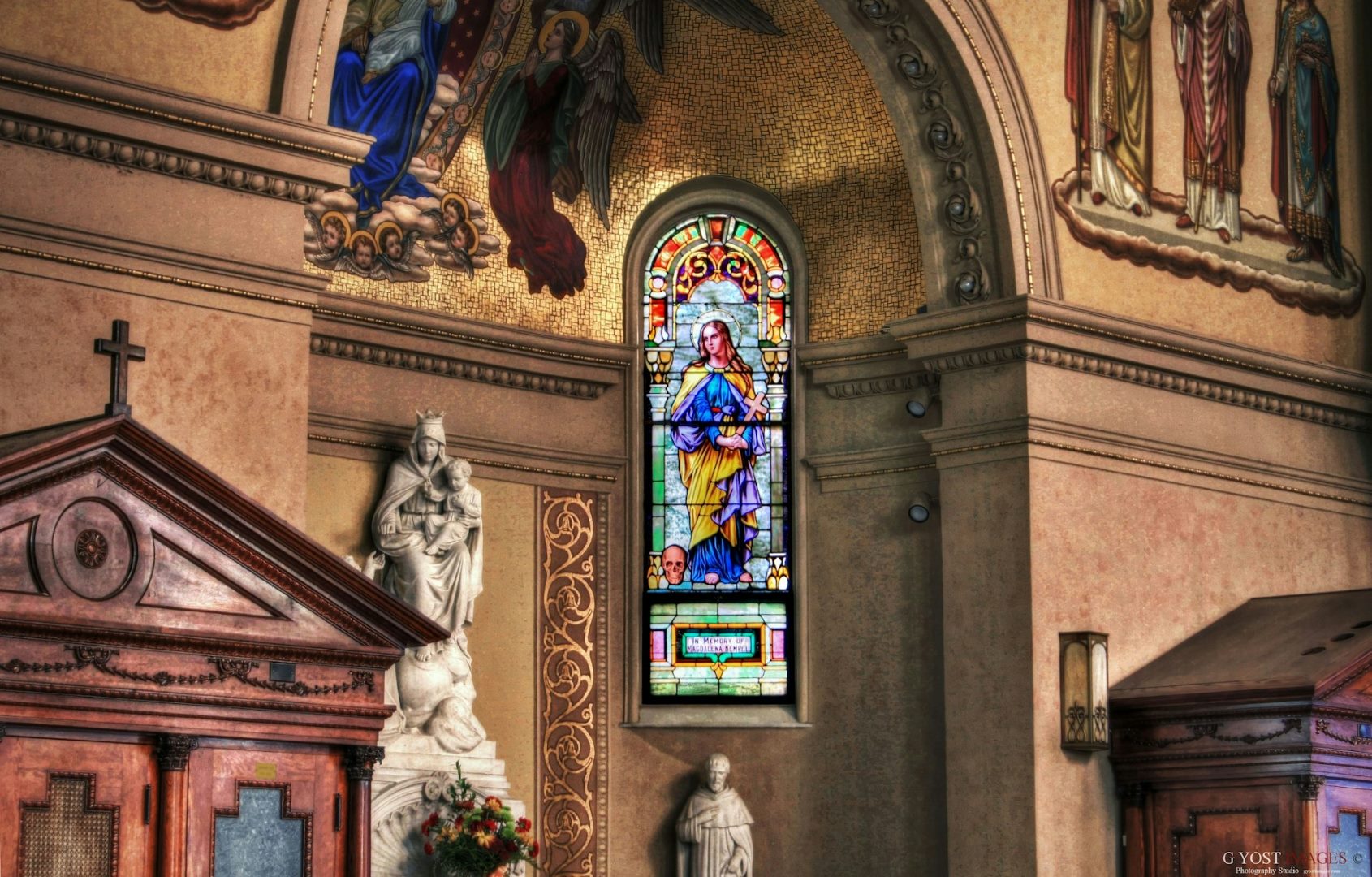
3. Gothic Architecture
Historical Background
Gothic architecture developed in the 12th century and flourished until the 16th century. It represented a shift towards more vertical and light-filled structures, aiming to inspire awe and draw the eyes heavenward.
Key Features
- Pointed Arches: The use of pointed arches allowed for greater height and more complex structures.
- Ribbed Vaults: Ribbed vaults distributed the weight of the roof more efficiently, enabling the construction of taller and more elaborate buildings.
- Flying Buttresses: External supports called flying buttresses allowed for thinner walls and larger windows.
- Stained Glass Windows: Large stained glass windows, often depicting biblical narratives, flooded the interiors with colorful light.
- Ornate Facades: The facades of Gothic churches were highly decorative, featuring intricate stone carvings, gargoyles, and statues of saints.
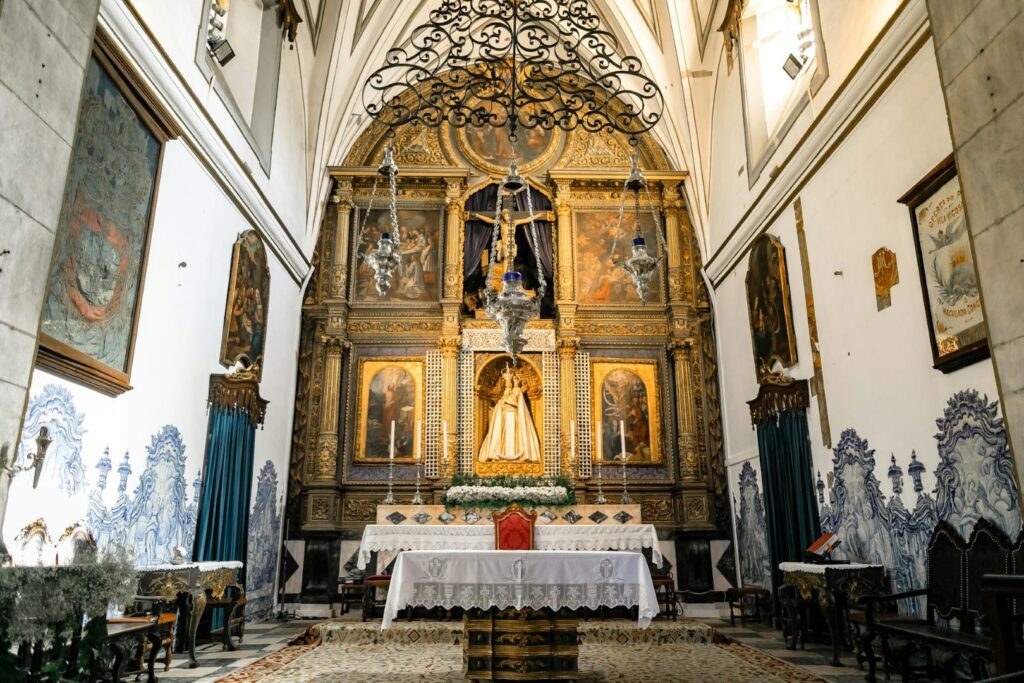
4. Renaissance and Baroque Architecture
Historical Background
The Renaissance (14th to 17th centuries) and Baroque (17th to 18th centuries) periods brought new styles influenced by classical antiquity and the desire for dynamic, expressive designs.
Key Features of Renaissance Architecture
- Symmetry and Proportion: Renaissance churches emphasized balance, symmetry, and proportion, drawing inspiration from the architecture of ancient Rome and Greece.
- Domes and Columns: The use of domes, columns, and pilasters became prominent, often combined with classical pediments and entablatures.
- Geometric Layouts: Church layouts often featured centralized plans or modified basilica plans, with an emphasis on harmony and clarity.
Key Features of Baroque Architecture
- Dramatic and Theatrical: Baroque architecture is characterized by its dramatic use of light and shadow, elaborate decorations, and a sense of movement.
- Curved Forms: The use of curves, ovals, and dynamic shapes created a sense of fluidity and grandeur.
- Ornamentation: Lavish ornamentation, including stucco, frescoes, and gilded details, enhanced the visual impact of Baroque churches.
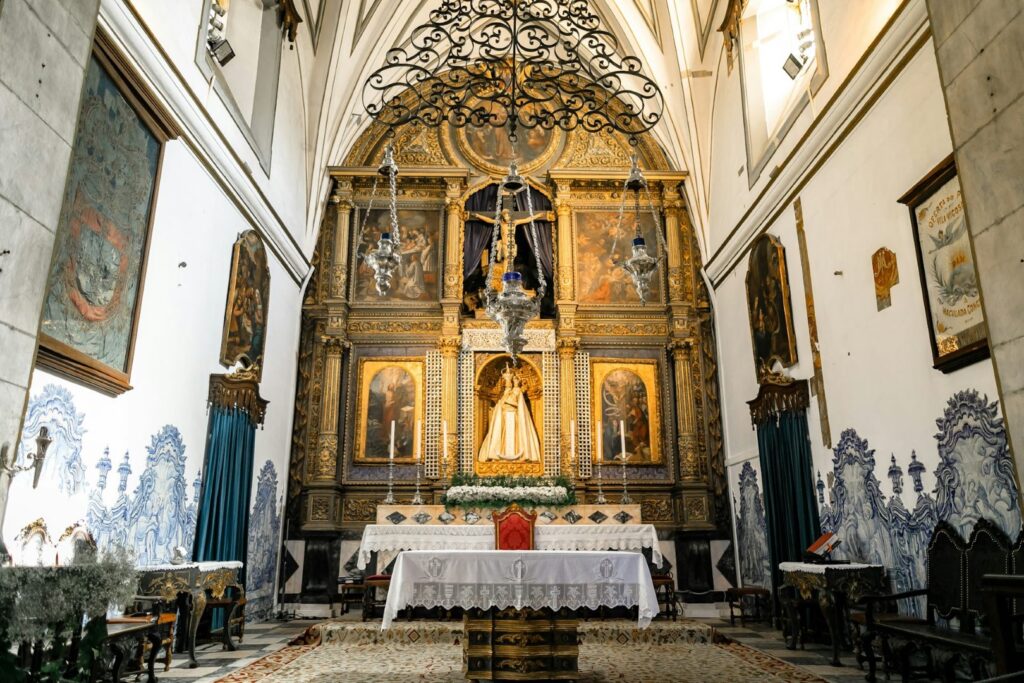
5. Modern Church Architecture
Historical Background
Modern church architecture, emerging in the 20th century, reflects changes in liturgical practices, technological advancements, and new aesthetic sensibilities. Architects began to experiment with new materials and forms, leading to innovative and diverse designs.
Key Features
- Simplified Forms: Modern churches often feature clean lines, simple forms, and minimal ornamentation, focusing on function and spirituality.
- Innovative Materials: The use of new materials, such as steel, glass, and reinforced concrete, allowed for greater flexibility in design.
- Natural Light: Emphasis on natural light and openness, often achieved through large windows and skylights, creates a sense of connection with the outside world.
- Functional Spaces: Modern churches are designed to accommodate various functions, including worship, community activities, and social services.
Conclusion
The evolution of church architecture is a testament to humanity’s enduring quest to create spaces that inspire, uplift, and connect us to the divine. From the sturdy Romanesque structures to the awe-inspiring Gothic cathedrals and the innovative modern designs, each architectural style reflects the values, beliefs, and technological capabilities of its time. Exploring these architectural masterpieces offers not only a glimpse into the past but also an appreciation for the creativity and devotion that continue to shape our sacred spaces.